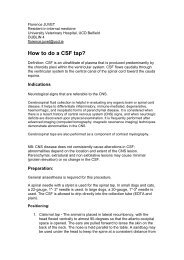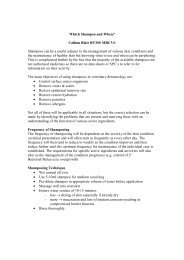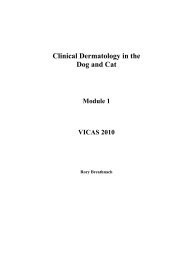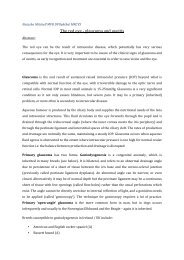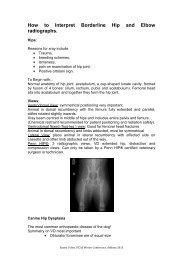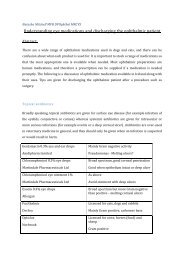TARSOCRURAL LUXATION - Love My Pet
TARSOCRURAL LUXATION - Love My Pet
TARSOCRURAL LUXATION - Love My Pet
- No tags were found...
Create successful ePaper yourself
Turn your PDF publications into a flip-book with our unique Google optimized e-Paper software.
(d) Open luxations should be considered emergencies. If the joint can be thoroughlydebrided within the "golden period" of 6 to 8 hours (possibly extended to 12 to 18 hours ifantibiotics are given immediately) then it may be possible toprevent the contamination from becoming established asinfection. The presence of the latter in a joint, particularlyone that is as tight-fitting as the tarsocrural joint, is likely toseverely compromise the end result. After this it might bepossible to consider ligament reconstruction or prostheticreplacement. However, it is often the case that much softtissue has been lost and collateral replacement wouldrequire a great deal of foreign material to be left in apotentially infected site. Instead it may be worth consideringthe application of a transarticular external skeletal fixator.This will stabilise the joint whilst soft tissue healing takesplace whilst at the same time allowing access to the woundsfor daily topical treatment. Such a frame is most easilyapplied to the medial aspect which works quite well in mostcases since the soft tissue loss is usually on the lateralaspect. In small patients, placement of the fixation pins intothe metatarsi can be difficult and the use of a Rudy bootmay side-step such a problem. The principle behind such a boot is to incorporate the distal pinsinto a cast applied to the pes rather than drilling them into the metatarsi. The fixator is left inplace for about 8 weeks and then, once soft tissue healing has taken place, surgery to correctany instability (as discussed above) can be reconsidered. It is the experience of many surgeonsthat the soft tissue healing is sufficient to restore stability and that a second operation is oftenunnecessary.(e) In cases where the techniques mentioned above have failed or where there is concurrentarticular damage which would compromise function in the long-term, it may be necessary toconsider tarsocrural arthrodesis as a salvage procedure. Several techniques to achieve this havebeen described (Stoll & others, 1975; Klause & others, 1989; Sumner-Smith & Kuzma, 1989) buttheir differences revolve around the method of stabilisation. In all cases, the articular cartilage isremoved either by making parallel cuts with an oscillating saw across the distal tibia and trochlearof the talus or by burring the cartilage off the subchondral bone whilst maintaining the articularcontours which then provide inherent postoperative stability. If an oscillating saw is used thenattention has to be paid to the angle of the cuts since this will determine the fixed angulation ofthe joint. The aim is to produce a weight-bearing angle which is considered to be 135-145 o in thedog and 115-125 o in the cat. Stability may then be achieved using a transarticular bone screw orTarsocrural Luxation - 4



